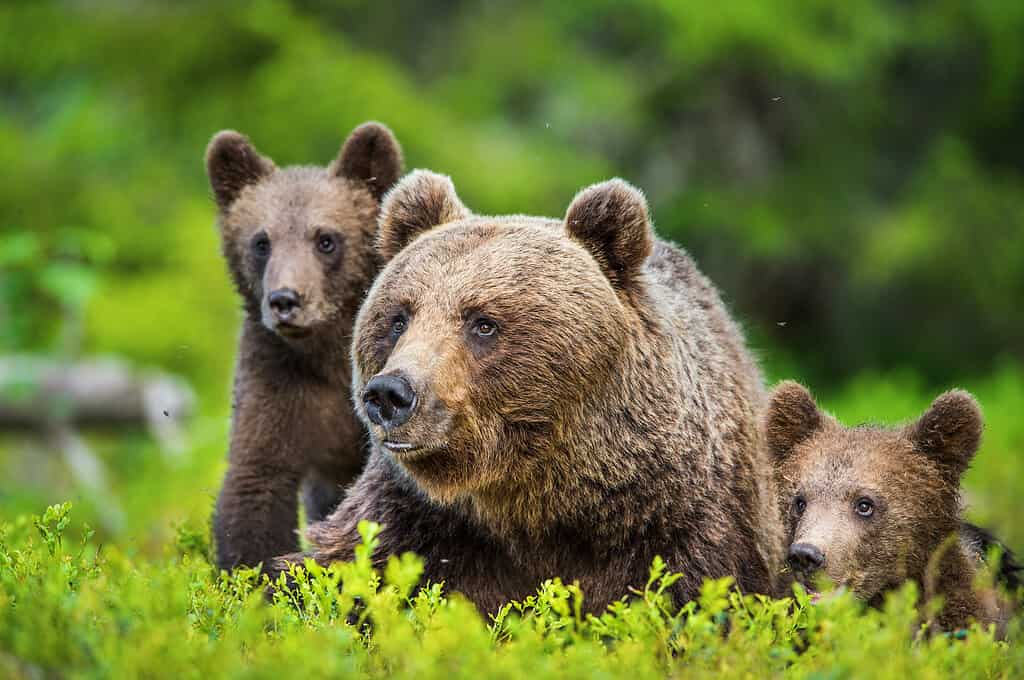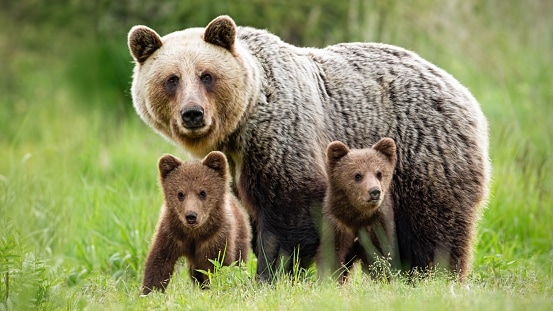Have you ever read an old folktale and felt stumped by the word “bruin”? A bruin isn’t some distant enigma – it’s a powerful creature that roams our forests and stirs our curiosity. Imagine a massive bear, sturdy and mighty, with fur as dark as midnight. This remarkable being is more than just its appearance – it’s a symbol of nature’s strength.
In this article, we’ll explore exactly what a bruin is, what it symbolizes, and some stories that involve the bruin in literary history.
What is a Bruin?
To put it simply, “bruin” is another word for a bear in English and other European folktales. A bruin is a remarkable creature that holds a special place in the natural world. With its powerful build and unique traits, a bruin symbolizes strength, adaptability, and resilience. The term “bruin” is likely derived from the Middle Dutch word “bruun” which means “brown”.
Physical Characteristics
Bruins are large mammals characterized by their robust bodies and thick fur. They come in various sizes, from the small black bears to the massive grizzlies. These creatures possess strong limbs, sharp claws, and keen senses, making them highly adept at navigating their environment. Their fur can range from light brown to dark black, helping them blend into different habitats.
Habitats and Adaptations
Bruins inhabit a diverse range of environments, including forests, mountains, tundras, and even swamps. Their ability to adapt to various landscapes showcases their resilience. They have a keen sense of smell, enabling them to locate food sources from a distance. Additionally, they are skilled climbers and swimmers, allowing them to access food and escape danger in different scenarios.
Diet and Feeding Habits
These creatures exhibit an omnivorous diet, consuming both plant matter and animal prey. They are opportunistic feeders, which means they adjust their diet based on what’s available in their surroundings. From foraging for berries and nuts to hunting smaller mammals and fishing for salmon, bruins display remarkable versatility in their feeding habits.
Behavior and Social Structure
Bruins are typically solitary animals, although they may interact with other bears during mating season or while sharing food sources. They communicate through various vocalizations, body language, and scent markings. During the colder months, they enter a period of hibernation, a survival strategy that helps them conserve energy when food is scarce.
Cultural Significance
Throughout history, bruins have held cultural significance in various societies. They appear in myths, legends, and artwork as symbols of strength and power. In some cultures, bears are revered as spiritual creatures or embody traits like courage and protection. Their presence in literature and folklore highlights their influence on human imagination and perception.
Conservation Status and Challenges
While bruin populations once faced significant threats due to habitat loss and hunting, conservation efforts have helped stabilize some bear species. However, challenges such as human-bear conflicts, illegal poaching, and climate change continue to impact these animals. Conservation initiatives focus on preserving their habitats, educating communities, and promoting coexistence.

The term “bruin” mostly refers to brown bears, but bears in general have had a place in English folklore for centuries.
©iStock.com/USO
The Symbolism and Meaning of Bruins
A bruin carries a profound symbolism that extends beyond its physical presence. These creatures, known for their robustness and endurance, symbolize essential qualities in various cultures and societies.
Strength and Power
The image of a bruin embodies strength and power. With their sturdy build and formidable claws, bears have been revered as symbols of might. This symbolism is rooted in their ability to navigate challenging landscapes and their prowess in hunting or foraging for sustenance.
Resilience and Adaptation
Bruins symbolize resilience and adaptation. Their diverse habitats, spanning forests to icy tundras, highlight their capacity to survive in different environments. Bears’ ability to adjust their diet and behaviors based on available resources underscores their adaptability, making them emblematic of overcoming adversity.
Spiritual and Cultural Significance
In numerous cultures, bears hold spiritual significance. Often associated with gods or revered as guardians, bears represent a connection to the spiritual world. Their hibernation, a period of rest and rejuvenation, has been linked to cycles of life, death, and rebirth in various belief systems.
Cultural Narratives
Bears feature prominently in myths and folklore. From ancient tales to contemporary stories, bears represent themes such as courage, protection, and transformation. These narratives portray bears as guides on journeys of self-discovery or as embodiments of natural forces.
Balance and Coexistence
The bruin’s symbolism extends to balance and coexistence. As apex predators, bears play a crucial role in maintaining ecosystems. Their interactions with other species underscore the delicate equilibrium within nature.
Modern Interpretations
In today’s world, the symbolism of a bruin remains relevant. As we face challenges like environmental changes and personal struggles, the bear’s traits of strength, resilience, and adaptability inspire us to navigate difficulties and embrace change.
A Reminder and Inspiration
In the realm of symbols, the bruin stands as a reminder of the intricate connections between nature, spirituality, and human experience. Its significance reminds us of the enduring qualities that can guide us through life’s journey, inspiring us to find strength within and coexist harmoniously with the world around us.
What Stories Have Bruins?
English folklore is rich with captivating stories that feature the bruin. These folktales weave together elements of nature, adventure, and symbolism, offering insights into the cultural values and beliefs of the past.
Geoffrey of Monmouth’s “History of the Kings of Britain”
This story in Arthurian legend can be found in Geoffrey of Monmouth’s “History of the Kings of Britain” as well as similar accounts in Lancelot-Grail literary cycle’s “Merlin” and Sir Thomas Malory’s “Le Morte d’Arthur”.
In the legend, King Arthur had a dream in which a dragon soars into the foreground and attacks a large bruin formed by black clouds. The dragon finally chops off the bear’s head after the beasts commence an intense battle. When Arthur Pendragon wakes up, he asks the seer of the ship what the dream could mean. The seer replied that the dragon symbolized Arthur and his army, while the bear represented his foes in a future battle. Arthur would succeed because the symbolic “bear” would be killed.
The Three Bears
The story of the Three Bears is a well-known English folktale involving bruins. It follows the tale of Goldilocks, a curious girl who stumbles upon the home of three bears while they are away. Intrigued by the bear family’s house, she enters and discovers three bowls of porridge. One bowl is too hot, another too cold, and the third just right. Hungry, she eats the porridge from the “just right” bowl.
Continuing her exploration, Goldilocks finds three chairs – one too big, another too small, and the third just right. She tests them out and breaks the smallest chair. Next, she comes across three beds – one too hard, another too soft, and the third just right. Goldilocks lies down on the “just right” bed, promptly falling asleep.
Upon returning home, the three bears – Papa Bear, Mama Bear, and Baby Bear – discover the mess and realize someone has been in their house. When they find Goldilocks sleeping, she awakens in surprise and flees in fear. The story of the Three Bears emphasizes the consequences of entering someone else’s home without permission and teaches the lesson of respecting others’ property.
Roman de Renart
The “Roman de Renart”, a medieval French fable, features a story involving a bear. In this tale, Renart the Fox tricks the bear, named Bruin, through cunning tactics. Renart convinces Bruin to stick his paw into a tree stump, promising that it holds honey. However, when Bruin’s paw gets stuck, he realizes he has been deceived.
Desperate to free himself, Bruin seeks the help of Isengrim the Wolf, another character in the fable. Isengrim suggests that they cut off Bruin’s paw to escape. Bruin hesitates but ultimately agrees. As they attempt to carry out the plan, they encounter the wise King Noble the Lion, who stops them just in time.
King Noble intervenes and punishes Bruin and Isengrim for their foolishness. Bruin’s encounter with Renart and the subsequent events highlight themes of deception, gullibility, and consequences. The story serves as a cautionary tale, illustrating the perils of blind trust and the traps that cunning individuals can set. Through Bruin’s misadventure, the “Roman de Renart” emphasizes the importance of critical thinking and avoiding hasty decisions.
Thank you for reading! Have some feedback for us? Contact the AZ Animals editorial team.








